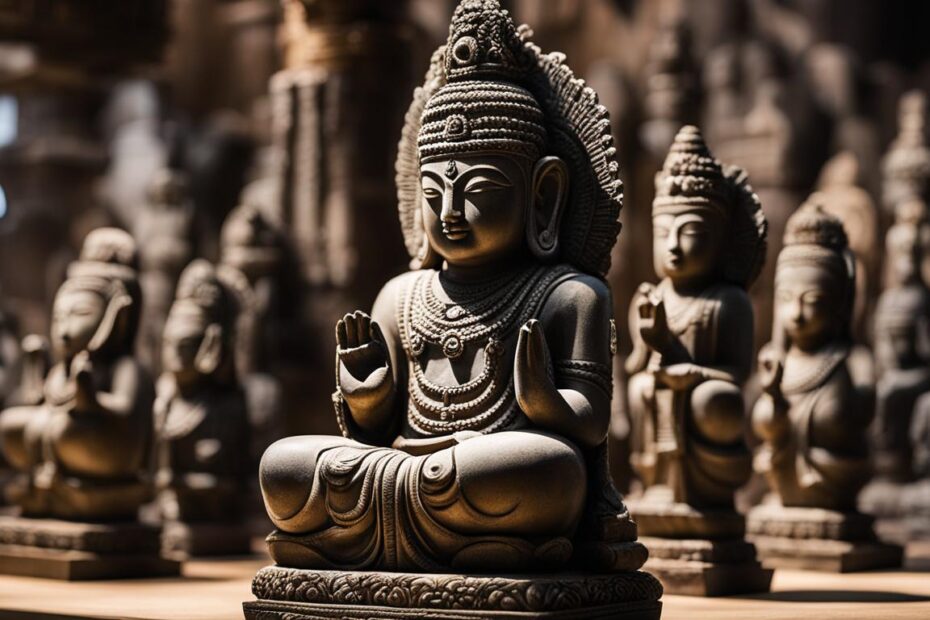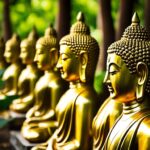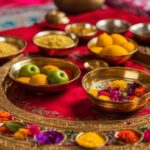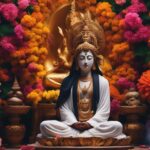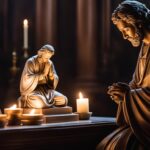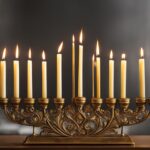In the Hindu tradition, a murti is a devotional image or statue of a deity or saint used during puja and other forms of expressing devotion. It is a symbolic representation of divinity and is not considered to be God itself. Murtis are commonly made from stone, wood, metal, or pottery. They vary in expression, from depicting angry deities symbolizing destruction to calm deities representing joy and harmony. Murtis play an important role in Hindu temples, homes, and festive processions.
Key Takeaways:
- Murtis are devotional images or statues used in Hinduism.
- They symbolize divinity and are not considered to be God itself.
- Murtis are made from various materials like stone, wood, metal, or pottery.
- They vary in expression and play an important role in Hindu worship and celebrations.
- Murtis are not worshiped as God but serve as a focal point for devotion and reverence.
Main Prayer Tools in Hinduism
The main prayer tools used in Hinduism include murtis (idols), incense, lamps (diyas), flowers, holy water (amrit), bells, conch shells, and sacred thread (rudraksha). These tools are integral to the practice of puja, a ritualistic form of worship in Hinduism. Each tool has its own significance and symbolism, contributing to the overall spiritual experience.
One of the primary prayer tools is the murti, which represents the presence of the deity being worshipped. Murtis are often intricately carved sculptures made from materials such as stone, wood, or metal. They serve as a focal point for devotion and are adorned with offerings and decorations during puja.
Incense is another essential prayer tool that is used to purify the atmosphere and create a fragrant ambiance during worship. The aroma of incense is believed to be pleasing to the deities and helps to elevate the spiritual experience. Similarly, lamps, or diyas, are lit to symbolize the removal of darkness and the illumination of knowledge.
| Prayer Tools | Symbolism |
|---|---|
| Murtis (Idols) | Presence of the deity |
| Incense | Purification and offering of prayers |
| Lamps (Diyas) | Removal of darkness and illumination of knowledge |
| Flowers | Beauty and purity |
| Holy Water (Amrit) | Purity and purification |
| Bells | Sacred sound and dispelling negative energies |
| Conch Shells | Primordial sound of creation |
| Sacred Thread (Rudraksha) | Protection and connection with divine energy |
These prayer tools are used with devotion and reverence during puja rituals, creating a spiritual connection with the deities and expressing gratitude and love.
How the Prayer Tools are Used in Practice
Puja rituals in Hinduism involve the use of various prayer tools to establish a spiritual connection with the divine. These tools are utilized in specific ways to express devotion and reverence. Here is a closer look at how some of the main prayer tools are used in practice:
Bathing the Murti
One of the essential rituals during puja is the bathing of the murti. This involves pouring holy water over the murti as a means of purifying and refreshing the deity’s presence. Devotees use a specially designed vessel called a kalash to pour water over the murti while chanting prayers. This symbolic act signifies the washing away of impurities and inviting divine blessings.
Offering Incense and Lamps
Incense and lamps are important elements used in puja to create a sacred and purified atmosphere. Incense sticks or cones are lit and waved in circular motions around the murti, filling the air with a fragrant aroma. Lamps (diyas) are also lit to symbolize the removal of darkness and the illumination of knowledge. These offerings are believed to please the deity and create a serene environment for worship.
Food Offerings and Aarti
Food offerings, known as prasad or bhog, are presented to the deity as a form of seva (service) and to seek blessings. Devotees offer fruits, sweets, and other vegetarian delicacies, which are later distributed as blessings from the divine. Aarti, a ritual where a lamp or flame is circulated in front of the murti, is also performed. This act signifies reverence and admiration for the deity, accompanied by the chanting of prayers and hymns.
By following these rituals and utilizing the prayer tools in a dedicated manner, devotees engage in a deeply enriching and ritualistic worship experience. The use of these tools serves as a medium to express love, devotion, and gratitude towards the divine.
The prayer tools used in Hinduism hold deep symbolic meaning and significance in the worship practices of devotees. Each tool represents a unique aspect of the divine and serves as a means of establishing a spiritual connection with the deity. Understanding the symbolism behind these prayer tools can enhance the experience of devotion and deepen one’s understanding of Hindu traditions.
Murti: Divine Presence and Focal Point of Devotion
The murti, or idol, is a central prayer tool in Hinduism. It represents the presence of the deity being worshipped and serves as a focal point for devotion. The murti can be made from various materials such as stone, wood, or metal, and its physical form embodies the qualities and characteristics of the deity. When a devotee offers prayers and performs rituals to the murti, they are connecting with the divine essence it represents.
Incense: Offering Prayers and Purifying the Atmosphere
Incense plays a vital role in Hindu worship as it symbolizes the offering of prayers to the divine. Lighting incense sticks during puja creates an aromatic atmosphere that purifies the surroundings and creates a sense of sacredness. The fragrance of the incense is believed to please the deities and attract their blessings. As the smoke rises, it carries the prayers and intentions of devotees to the divine realms.
Lamps: Illuminating Knowledge and Removing Ignorance
Lamps, or diyas, hold deep symbolism in Hinduism. They represent the removal of darkness and the illumination of knowledge. Lighting a lamp during puja signifies the dispelling of ignorance and the pursuit of spiritual enlightenment. The flame of the lamp is believed to attract positive energies and drive away negative forces. It also symbolizes the divine light within each individual and the eternal flame of consciousness.
| Prayer Tools | Symbolism |
|---|---|
| Murti | Divine presence, focal point of devotion |
| Incense | Offering prayers, purifying the atmosphere |
| Lamps | Illuminating knowledge, removing ignorance |
These prayer tools form an integral part of Hindu worship, allowing devotees to express their devotion and establish a spiritual connection with the divine. Each tool holds deep symbolism and significance, reminding individuals of the divine presence in their lives and guiding them on their spiritual journey.
Variations in Prayer Tools Among Sects
In Hinduism, there are various sects that have their own unique rituals and worship practices. These differences manifest in the use of prayer tools as well. While the core prayer tools remain the same across sects, there are variations in how they are used and the specific rituals associated with them. This reflects the diverse beliefs and traditions within Hinduism.
Variations in Deity Emphasis
One of the main differences among sects in Hinduism is the emphasis placed on certain deities. For example, some sects may focus primarily on the worship of Lord Shiva, while others may prioritize the worship of Lord Vishnu or Goddess Durga. This difference in deity emphasis can influence the types of prayer tools used and the specific rituals performed.
| Sect | Emphasized Deity | Associated Prayer Tools |
|---|---|---|
| Shaivism | Lord Shiva | Trident (Trishul), Rudraksha beads, Ashes (vibhuti) |
| Vaishnavism | Lord Vishnu | Conch shell (shankha), Tulsi beads, Mark on forehead (tilak) |
| Shaktism | Goddess Durga | Trident (Trishul), Sacred thread (mangalsutra), Kumkum (vermilion) |
Differences in Rituals
Each sect in Hinduism may also have its own specific rituals and practices when it comes to worship. These rituals can involve the use of particular prayer tools and may vary in their intricacy and duration. For example, some sects may have elaborate fire ceremonies (yagnas), while others may focus more on intimate, personal offerings and prayers.
“The diversity in worship practices among Hindu sects is a testament to the richness and adaptability of the religion. It allows individuals to find their own unique paths of devotion, while still being part of a larger spiritual community.”
Sect-Specific Prayer Tools
In addition to variations in deity emphasis and rituals, some sects in Hinduism have their own specific prayer tools that are distinct to their tradition. These tools may have symbolic meanings and are used in sect-specific rituals. One example is the chakra (discus) used in Vaishnavism to symbolize Lord Vishnu’s divine presence and protection.
Materials Used for Prayer Tools
The prayer tools used in Hinduism are crafted from various materials, each carrying its own significance and cultural heritage. The choice of material reflects the craftsmanship and traditions of different regions. Here are some commonly used materials for prayer tools:
Stone:
Stone murtis are popular and widely used in Hindu worship. Marble and granite are commonly carved to create intricate and detailed statues. Stone murtis are known for their durability and timeless beauty.
Wood:
Wooden murtis showcase the skill of skilled artisans who carve them from different types of wood. Each wood has its own unique characteristics and symbolism, adding depth to the spiritual significance of the murtis.
Bronze:
Bronze statues are created using metal casting techniques. They are often adorned with intricate details and symbolism, representing the divine in a visually stunning way. Bronze murtis are highly valued for their craftsmanship and artistry.
Other Metals:
Prayer tools are also crafted from various other metals such as brass, copper, and silver. These metals are chosen for their aesthetic appeal and their ability to withstand the test of time.

The use of these materials not only enhances the visual appeal of the prayer tools but also adds a sense of sacredness and reverence to the act of worship. Each material carries its own symbolism and cultural significance, deepening the spiritual connection between the devotee and the divine.
Evolution of Prayer Tools Over Time
Over the centuries, the practice of using prayer tools in Hinduism has evolved, adapting to the changing needs and preferences of devotees. One significant aspect of this evolution is the design of murtis, which have become more intricate and detailed in their craftsmanship. Advancements in sculpting techniques have allowed artisans to create murtis that are lifelike and visually stunning, capturing the essence of the deities they represent.
Modern technologies have also had a profound impact on the evolution of prayer tools. Fiberglass and resin are now commonly used materials for creating murtis, offering durability and versatility. These materials allow for greater range in size, shape, and design, enabling murtis to be displayed in a variety of settings, from traditional temples to contemporary home altars.
The evolution of prayer tools is not limited to murtis alone. Other tools, such as lamps and incense holders, have also undergone changes over time. Traditional oil lamps have been replaced with electric ones for convenience, while incense holders now come in a range of designs, from classic brass to modern ceramic.
The Modernization of Puja Accessories
Moreover, the way prayer tools are used in practice has also been influenced by modernization. With the advent of technology, digital versions of prayer tools, such as virtual lamps and incense, have emerged. These digital alternatives provide an accessible and convenient way for devotees to engage in worship, especially for those who may be unable to physically visit a temple or have limited space for prayer rituals.
While the evolution of prayer tools has undoubtedly brought about positive changes, it is essential to maintain the core spiritual significance behind their usage. Whether traditional or modern, the intention remains the same – to create a sacred space and establish a connection with the divine. The evolution of prayer tools ensures that individuals can engage in worship in a way that resonates with them personally, while still honoring the deep-rooted traditions of Hinduism.
Lesser-Known Prayer Tools
In addition to the main prayer tools discussed in previous sections, there are several lesser-known accessories used in Hindu worship. These unique prayer tools, while not as commonly known or used, play a significant role in certain religious traditions, adding depth and richness to the worship experience.
Sacred Threads
One such accessory is the sacred thread, also known as the ‘Yagnopaveetham’ or ‘Janeu’. This thread is typically worn by males of the Brahmin caste and is considered a symbol of their commitment to spiritual growth and seeking knowledge. The sacred thread is made of cotton and consists of three strands, representing the Hindu gods Brahma, Vishnu, and Shiva.
Sacred Ashes (Vibhuti)
Vibhuti, or sacred ashes, hold deep significance in Hindu rituals. They are typically obtained by burning dried cow dung or sacred herbs. Vibhuti is believed to have purifying and protective properties and is often applied to the forehead or other parts of the body during prayer or religious ceremonies.
Sandalwood Paste (Chandan)
Chandan, or sandalwood paste, is highly regarded in Hindu worship. It is made from grounding sandalwood sticks and water, resulting in a fragrant and cooling paste. Chandan is often applied to the forehead, neck, and other parts of the body as a way of invoking spiritual purity and tranquility.
Sacred Powders (Kumkum)
Kumkum, also known as vermilion, is a vibrant red powder made from drying and grinding turmeric. It holds great significance in Hindu rituals and is often used to make ‘bindis’, which are worn on the forehead by married women as a symbol of their marital status and devotion. Kumkum is also used to mark the third eye during religious ceremonies.
These lesser-known prayer tools offer unique ways to deepen one’s spiritual connection and engage in devout worship. While they may not be as widely recognized as the main prayer tools, their symbolism and significance contribute to the rich tapestry of Hindu religious practices.

Conclusion
The use of murtis and other prayer tools in Hinduism is a deeply rooted tradition that carries great spiritual significance. These tools serve as a means of expressing devotion and reverence to the divine. The main prayer tools, such as murtis, incense, lamps, flowers, holy water, bells, conch shells, and sacred thread, are used during puja rituals to create a spiritual connection with the deity.
Each prayer tool carries symbolic meaning and serves a specific purpose in Hindu worship. Murtis represent the divine presence, incense purifies the atmosphere, and lamps symbolize the removal of ignorance. Flowers symbolize purity and beauty, while holy water signifies purification. The ringing of bells creates a sacred sound, and the blowing of the conch shell represents the primordial sound of creation.
There are variations in the use of prayer tools among different sects in Hinduism. While the core prayer tools remain the same, each sect may have its own specific rituals and preferences. The materials used for prayer tools, such as murtis, vary depending on the region and tradition. Stone, wood, and bronze are commonly used, reflecting the cultural heritage and traditional craftsmanship.
Over time, prayer tools have evolved in design and materials. Advancements in sculpting techniques have allowed for more intricate and detailed murtis. Modern technologies have also introduced materials like fiberglass and resin, making prayer tools more accessible and versatile. Additionally, there are lesser-known prayer tools, such as sacred threads, sacred ashes, sandalwood paste, sacred powders, and special garlands, which play a significant role in certain traditions.
FAQ
What is a murti in Hindu tradition?
A murti is a devotional image or statue of a deity or saint used during puja and other forms of expressing devotion in the Hindu tradition. It is a symbolic representation of divinity and is not considered to be God itself.
What are the main prayer tools used in Hinduism?
The main prayer tools used in Hinduism include murtis (idols), incense, lamps (diyas), flowers, holy water (amrit), bells, conch shells, and sacred thread (rudraksha). These tools are used during puja, which is a ritualistic form of worship.
How are the prayer tools used during puja?
The murti is bathed with holy water, decorated with flowers, and offered incense, lamps, and food as a form of seva (service). Devotees also perform aarti, where they circulate a lamp or flame in front of the murti to show reverence. The conch shell is blown to mark the beginning and end of the puja, while the bell is rung to create a sacred sound.
What is the symbolism behind the prayer tools?
Each prayer tool carries symbolic meaning in Hinduism. The murti represents the divine presence and serves as a focal point for devotion. Incense symbolizes the offering of prayers and purifies the atmosphere. Lamps represent the removal of ignorance and the illumination of knowledge. Flowers symbolize beauty and purity, while holy water signifies purity and purification. Bells create a sacred sound that drives away negative energies, and the conch shell represents the primordial sound of creation.
Do different sects in Hinduism have variations in their prayer tools?
Yes, there are variations in the use of prayer tools among different sects in Hinduism. Each sect may have its own specific rituals and preferences when it comes to worship practices. While the core prayer tools remain the same, the way they are used and the specific rituals associated with them may differ.
What materials are used for prayer tools?
The materials used for prayer tools vary depending on the region and tradition. Murtis can be made from stone, wood, bronze, or other metals. The choice of material often reflects the cultural heritage and traditional craftsmanship of a particular region.
How have prayer tools evolved over time?
The design and craftsmanship of murtis have become more intricate and detailed, reflecting advancements in sculpting techniques. Additionally, modern technologies have allowed for the creation of murtis using materials such as fiberglass and resin. These innovations have made murtis more accessible and versatile in various settings, from traditional temples to home altars.
Are there any lesser-known prayer tools used in Hindu worship?
Yes, there are lesser-known accessories used in Hindu worship, including sacred threads, sacred ashes (vibhuti), sandalwood paste (chandan), sacred powders (kumkum), and special garlands. These items have specific symbolic meanings and are used in specific rituals or for certain deities.
What is the significance of prayer tools in Hindu worship?
The use of murtis and other prayer tools in Hinduism is a deeply rooted tradition that carries great spiritual significance. These tools serve as a means of expressing devotion and reverence to the divine. By understanding the beauty and meaning behind these prayer tools, individuals can create a sacred space that inspires devotion and leads to spiritual growth.


